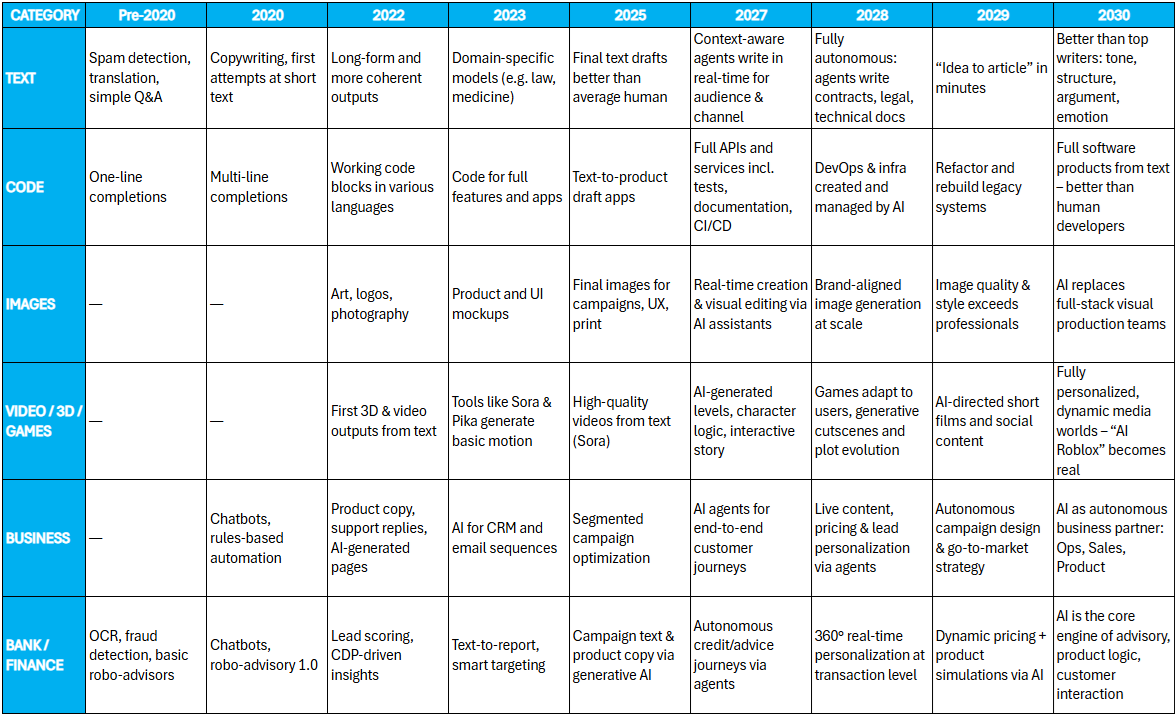Beyond Automation: How Generative AI Brings the Next Boost to Innovation
Digitalization has fundamentally changed marketing – and now the next revolution is upon us: Generative Artificial Intelligence (GenAI). What was previously considered a futuristic gimmick is increasingly becoming a powerful tool that automates creative processes, enables personalized experiences in real time, and offers companies new scaling opportunities.
What is Generative AI?
Generative AI refers to AI models that generate new content – text, images, videos, music, or code – based on existing data. By training with vast amounts of data, these models can not only reproduce existing content but also deliver creative, often surprising results. This is fundamentally changing the marketing sector in particular.
The Development of Generative AI in Various Sectors
Generative AI has evolved rapidly in recent years. While initially text-based models dominated, image, video, and even music generation have now reached an impressive level. Let’s take a look at the most important sectors and their development:
- Text Generation (2000 – Future)
Early models were rule-based and offered limited capabilities. With GPT-3 and subsequent models, quality improved significantly. Today, AI-generated texts are almost indistinguishable from human content. In the future, they could become even more context-sensitive through improved semantic analysis. - Image and Video Generation (2015 – Future)
The first AI models for image generation were primitive, but with DALL·E and MidJourney, AI tools emerged that take artistic quality to a new level. In the future, video generators will create content in real time, radically changing marketing. - Music and Audio Generation (2020 – Future)
AI-powered music generation is still in its infancy, but advances in neural networks are already enabling customized soundtracks for marketing campaigns and brand identities. - Code Generation (2018 – Future)
AI-powered development tools like GitHub Copilot help developers work more efficiently. The future could bring almost fully automated code generation with customized software at the touch of a button. - Business Automation (2020 – Future)
Generative AI optimizes business processes through intelligent automation. From AI-powered sales assistants to automatic customer segmentation and real-time campaign planning, companies can significantly increase their efficiency. In the future, AI will help develop entire business strategies and optimize sales processes fully automatically. - Banking and Finance (2020 – Future)
Financial institutions are increasingly relying on generative AI for fraud prevention, personalized advice, and dynamic pricing. AI-based robo-advisors enable automated investment recommendations, while smart AI agents optimize lending decisions. In the long term, AI could act as co-CEO and develop data-driven strategies for banks and financial service providers.

How is Generative AI changing marketing?
- Real-time hyperpersonalization
Customers today expect personalized experiences. Generative AI analyzes customer behavior, automatically segments, and creates tailored content in seconds – whether for email campaigns, social media ads, or personalized websites. - Scalable content production
Companies need to create high-quality content faster and more efficiently. With GenAI, blog articles, white papers, or social media posts can be generated in a very short time – without compromising on quality. - New creative impulses
Instead of replacing human creativity, GenAI complements it. Brands use AI to generate ideas, brainstorm, and develop innovative campaigns that were previously unimaginable. - Automation of Routine Tasks
From A/B testing to ad copy optimization: Generative AI takes over repetitive tasks and gives marketers more time for strategy and creativity. - Interactive Customer Experiences
Chatbots and virtual assistants are becoming more intelligent, context-aware, and able to offer a genuine, human-like interaction with customers thanks to GenAI.
Challenges and Ethical Issues
With this new technology comes challenges. Issues such as copyright, misinformation, and bias in AI models must be addressed. Companies should handle Generative AI responsibly and ensure that transparency and ethics are maintained.
Conclusion: The Change Is Now
Generative AI is not a distant vision of the future, but a reality that is fundamentally transforming marketing. Companies that address its possibilities early on can secure a decisive competitive advantage. Those who act now are actively shaping the future of marketing.